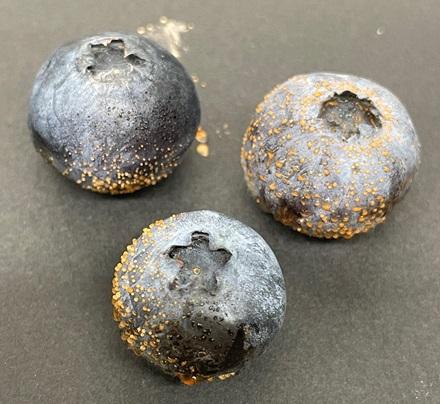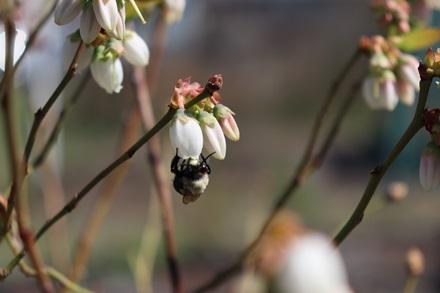Boosting Blueberries by Benefitting Bees
From the outside, blueberries may look simple, but they contain multitudes: each flower the plant produces holds a universe of complex microorganisms inside it, competing, collaborating, and collectively, determining the fate of the berry. Now ARS researchers are learning more about those interactions in an effort to boost blueberry output, and protect the pollinators on which the berries depend.
Caitlin Rering is a research chemist in the ARS Center for Medical, Agricultural and Veterinary Entomology in Gainesville, FL. Recently, she has been exploring ways to combat anthracnose, a disease that is a long-standing enemy of farmers, including those who grow berries. Anthracnose is caused by a number of different fungal species belonging to the genus Colletotrichum. In blueberries, this pathogen infects flowers but remains undetectable until it is too late; when it does finally appear, it has already destroyed the mature fruit.

Blueberries infected by the anthracnose fungus show clear damage, rendering them inedible. Photo credit: Alexia Lanier.
As a result, growers’ main defense has been a very aggressive offense, using fungicides early and widely. That approach has been considered benign – until recently.
Increasing evidence suggests that the fungicides have cumulative toxic effects that harm bees, which play a critical role in pollinating the berries. To avoid this danger, Rering and her colleagues looked for a different solution within the blueberry flower itself. While nearly all flowers contain complex communities of microorganisms, each is unique, so Rering and her team delved into learning which microbes specific to the blueberry flower might already be providing it with some defense against pathogens. By working with the plant’s biology, Rering bet that she could combat anthracnose without harming pollinators.
She and her team were not disappointed: among the organisms in the flower’s native microbial community, they identified fungi and bacteria that seemed to offer protection from anthracnose. After determining which microbes were most promising in the lab, they set out to test the candidate microbes in the real world. The work was detailed and arduous, involving months-long experiments in carefully laid-out blueberry fields planted specifically for the research. The team’s hope was that the beneficial microbes could ultimately be produced on a large scale and made available for farmers to apply in their own blueberry operations.
Because the microbes the team tested co-evolved with the blueberry plant and its pollinators, they appear to be configured well to work with them, unlike fungicides or other previous approaches.
“There have been issues in the past with non-native microbes in flowers,” said Rering. “The bees don’t like them, so you have reduced yields – the fruit is tiny and not something consumers are interested in.”
Rering described her solution as “highly tuned to fit the system where it’s intended to be applied. Flowers are this delicate interface where we have pollinators, herbivores, neutral or beneficial microbes, pathogens, and the surrounding environment all interacting. If you just start throwing in random stuff that’s alien to that system, you can have a lot of unintended consequences.”

A bumble bee collects nectar from a blueberry flower in the experimental fields that were established for Rering’s research project. Photo credit: Caitlin Rering
Notably, Rering’s team also confirmed that the beneficial microbes were not found alive in the final fruit, or in the hives of the bees that pollinated it, alleviating potential concerns that growers or consumers might have.
With encouraging results in hand, Rering is looking ahead to additional tests, and other possible applications of her discovery. Cranberries, for instance, are vulnerable to the same anthracnose threat, and Rering believes that their biology is similar enough that her solution might be effective for them as well.
At a time when pollinators are already under threat on multiple fronts, a solution that not only avoids harm, but actively supports both bees and fruit plants could be a powerful addition to growers’ toolset.
“If we’re triaging problems in agriculture,” Rering said, “I think of protection of our pollinators – both managed and wild – as being really high up on the priority list for food security.” – By Kathryn Markham, ARS Office of Communications

